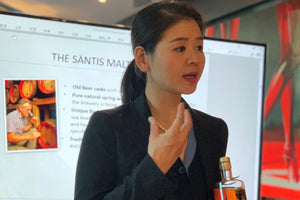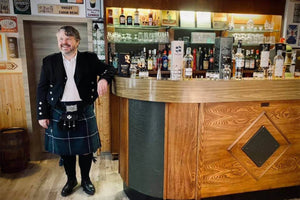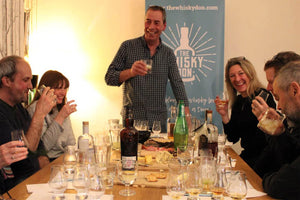Ferintosh: Scotland’s First Whisky Region
For whisky historians, the name Ferintosh carries deep significance. Famed for producing high-quality spirit long before the modern idea of 'whisky regions' emerged, the name is making headlines again centuries after its distilling heritage was lost.
A planning application has recently been submitted to Highland Council for for a new distillery, warehouse and visitor centre at Mulchaich Farm on the Black Isle. The project raises the prospect of the return of whisky distilling to Ferintosh, Scotland’s first famous whisky region. This move has sparked fresh interest in Ferintosh’s historical importance, but what made it so special in the first place? We asked whisky writer Iain Russell to explain...
In the beginning, there was Ferintosh.
Ferintosh was Scotland’s first recognised Scotch whisky region. Such was its fame that it became synonymous with the best Scotch malt whisky, widely advertised and celebrated in the works of some of Scotland’s greatest authors and poets. As early as 1697, the Scottish traveller and writer Martin Martin alluded to the legendary status of the place and its whisky when he wrote that ‘The children of Ferintosh in Ross are taught in their infancy to drink aquavitae and are never observed to be troubled with worms.’

Aberdeen Press and Journal, 16 August 1784.
There’s a common misconception that Ferintosh disappeared from the whisky scene at the end of the 18th century, when the poet Robert Burns famously lamented its loss in verse. But, on the contrary, the name lived on in popular memory.
Ferintosh is a large estate in the Highlands of Scotland, lying to the south and east of Dingwall in Easter Ross. In the late 17th century it was held by Duncan Forbes of Culloden, a politician who supported the deposition of King James II during the ‘Glorious Revolution’ of 1688-89. In consequence a local minister wrote later, Jacobite forces ‘laid waste his estates, particularly the barony of Ferintosh, and destroyed extensive distilleries, of which it was the seat at that time.’

Act of Parliament granting Duncan Forbes an exemption from Excise duty on whisky made in the lands of Ferrintosh [sic], ‘an Ancient Brewary of Aquavity’.
Forbes was compensated by the Scottish Parliament for his losses in 1690, with the grant (in return for a nominal annual payment) of an exemption from paying Excise duty on spirits distilled on the estate using locally-grown barley. It was a highly profitable reward, as Ferintosh became Scotland’s most productive whisky-making region. By the 1780s, indeed, distilleries working on the estate were producing over 100,000 gallons of spirits per annum – sometimes equalling the combined output of all the country’s duty-paying distilleries combined. At its peak, as many as 1,000 local people were said to have been employed in distilling. The whisky was shipped all over the United Kingdom, and there was even a Ferintosh warehouse in London, to store supplies sent to the capital.
Landlords and whisky makers from other parts of the Highlands complained bitterly that the Ferintosh distillers, exempted from paying onerous Excise duties, could drastically undercut the prices of their competitors. Not only that, but they began importing barley from neighbouring areas to meet their growing needs, in direct contravention of the stipulation that only local barley could be used. The Government was persuaded to intervene. In 1784, during one of the periodic shake-ups of the Excise laws in Scotland, Ferintosh’s exemption from Excise duty was cancelled with Forbes receiving the huge sum of more than £21,000 In compensation.
The withdrawal of the exemption had an immediate impact on the estate, with an exodus of skilled whisky makers. According to the local minister, writing in 1793, ‘their supposed superior skill in the business to which they had been inured’ meant that there was ‘a demand of hands from Ferintosh, wherever distilleries were erected under the new Act of Parliament [the Wash Act of 1784]’. Many left and began working stills in other parts of Easter Ross and beyond. Robert Burns was one of those who thought the famous whisky would simply disappear from the market, lamenting in 1785:
“Thee, Ferintosh! O sadly lost!
Scotland lament frae coast to coast!
Now colic grips, and barkin' hoast
May kill us a';
For loyal Forbes's charter'd boast
Is ta'en awa'!”
But the name of Ferintosh was far from lost.
Within a few years, it was reported that there were 29 licensed distilleries at work in Ferintosh and in the neighbouring estates. Although distilleries such as Ryefield, Easter Linack and Taynahinch [Tighnahinch] failed during the economic recessions and upheavals which plagued the industry in the early 19th century, ‘Ferintosh’ had by then become the popular name adopted for good malt whisky made in the north-east of Scotland – much as ‘Glenlivet’ was to become the generic name for whisky from the Strathspey in later years. Sir Walter Scott, the famous Scottish author and whisky aficionado, wrote in 1813 that he had ‘plenty of right good and young Highland Ferintosh' in his cellar. In 1845 another celebrated writer, William Aytoun (1813-65), expressed a preference for ‘Ferintosh’ in verse:
“In Campbelltown my luve was born,
Her mither in Glen Turrit!
But Ferintosh is the place for me,
For that’s the strangest speerit!” *
[*strangest speerit = strongest spirit]

Inverness Courier, 20 December 1826.
The name of Ferintosh fell out of favour as a popular name for whisky from the North-Eastern Highlands during the later nineteenth century. However, it was revived for a time in Dingwall, just north west of the estate. The Ben Wyvis Distillery was built there in 1879, and after it was acquired in 1893 by the Irish company Kirker Greer, the name was changed to the Ferintosh Distillery. It was subsequently acquired by the Distillers Company Ltd, who closed the distillery in 1926 but continued to mature casks in the warehouses until the 1980s. The site was subsequently redeveloped for housing in 1993.

Clyde Bill of Entry, 15 August 1889.
While the name of Ferintosh is rarely mentioned apart from in history books today, its importance and significance in the early development of the Scotch whisky industry has not been forgotten. And although the distilleries on the estate are long gone, the whisky-making tradition that they began lives on in Easter Ross at famous old distilleries such as Balblair, Glen Ord, Teaninich, Dalmore and Glenmorangie – the heirs of Ferintosh.










1 comment
This is a great piece of history. I grew up in the area and vaguely remember my grannie talking about the number of stills in area. I had no idea it was so extensive. So interesting. H